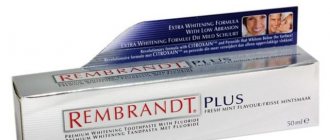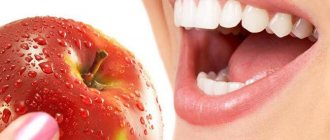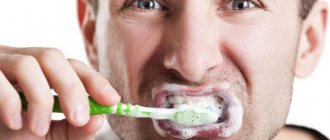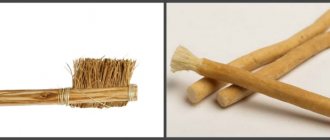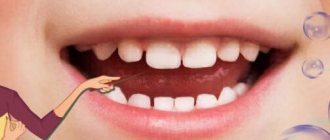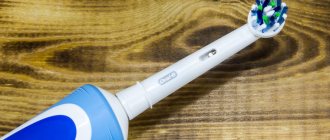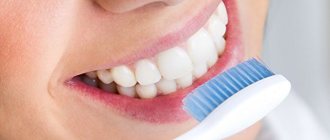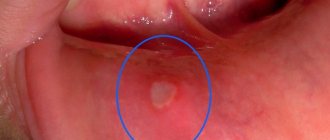Dentists recommend various medications and procedures for cleaning and whitening teeth. But to get excellent results, you don’t have to shell out a lot of money. There are methods that can achieve impressive results at home using inexpensive products such as activated carbon.
Brushing teeth with activated carbon
Beneficial features
Coal is sold at any pharmacy. Its main advantage is the ability to absorb harmful substances that enter the body and remove them. Therefore, doctors prescribe the drug to the patient for rotavirus infection, poisoning, and hangover.
The medicine neutralizes toxins, preventing the development of intoxication.
The use of coal is not limited to this. At home it is used to lighten teeth. The effect is based on the same property - absorption ability. Charcoal collects plaque and removes it from the enamel, leaving it crystal clear.
If yellowing or darkening of teeth is associated with the appearance of plaque, they will become half a tone whiter.
What is teeth whitening with activated carbon?
Photo shows teeth whitening with activated carbon
Activated carbon is a unique medicine that is constantly used in medicine. We are talking about vegetable or animal coal that can be processed. Its main property is its absorbent function, so it quickly absorbs any toxins, salts, poisons and pollution. It begins to act immediately after contact with liquid, which is why it is used together with water. But teeth whitening at home with charcoal must be done carefully, as it can not only remove plaque and dirt, but also damage the surface.
By the way, charcoal in the old days was also quite common and popular among women who wanted to whiten their teeth. But later, when it became known about its beneficial qualities, manufacturers began to add other components to the composition to enhance the therapeutic effect.
The whitening properties of activated carbon are due to its abrasive consistency. After all, solid elements easily remove plaque, dirt, and traces of tea and coffee. Usually the result is noticeable within a couple of weeks.
Important! There is coal with the addition of nut shells or fruit seeds; it is considered the most useful. Due to its beneficial effects on the general condition of the oral cavity. But you don’t have to buy it; you can get by with the classic one.
- See also: what is a teeth whitening tray?
Pros and cons of coal
Black natural absorbent will clean your teeth if you have plaque formed after drinking coffee, chocolate and the habit of smoking a cigarette or two. Advantages of the method:
- low cost;
- availability;
- safety (if it gets on the mucous membranes or in the stomach there will be no harm);
- ease of use.
If desired, anyone can use the method at home without taking the time to visit the dentist.
Note! The method has disadvantages. Minuses:
- the remaining coal takes a long time to wash away;
- teeth become sensitive to cold and hot food;
- damage to the enamel is possible.
Ready to try some recipes? First, read the contraindications - they exist, like any medical procedure.
Cautions
You cannot remove carbon deposits if:
- you have bleeding gums;
- have caries;
- gum disease is present;
- braces installed;
- Braces recently removed;
- attacks of stomatitis often occur;
- increased abrasion of enamel.
In each of the cases described, the problem will get worse. Bleeding will increase because the gums will experience microdamage. The carious cavities will expand as coal particles get into them. Gingivitis and periodontitis will worsen - before teeth whitening, the disease must be put into remission.
In places where coal particles get under braces, caries develops. If you have just had a dental appliance removed, your teeth will have an uneven shade and are also sensitive. Charcoal bleaching will add problems. Stomatitis must be treated first so that the coal does not get into small wounds and irritate the mucous membrane.
Increased abrasion of enamel is an absolute contraindication. Bleaching will lead to stains and the onset of tooth decay.
Contraindications and harms of teeth whitening with charcoal
Teeth whitening with activated carbon at home has several contraindications that must be strictly adhered to:
- Braces . If the patient has recently removed braces, then it is not worth carrying out the procedure right away.
- Caries and tooth sensitivity . There is a high probability of damaging the enamel and aggravating the situation.
- Childhood . Children's tooth enamel is not yet fully formed and is quite thin, and such a procedure will only harm it.
Before whitening, it is recommended to consult a dentist, who will assess the condition of the oral cavity and identify possible problems.
When performing teeth whitening with charcoal, you may encounter a number of side effects:
- Frequent procedures can damage tooth enamel.
- Residues of coal remain between the teeth and in small cracks, so removing them will take some time.
Important! The abrasive elements in coal can scratch the surface and create small cracks. Over time, they will enlarge, thinning the enamel and causing tooth decay. In this regard, lightening is carried out in courses and is not repeated more than 1-2 times a week.
- Read on: How to whiten teeth at home
Photos before and after
If you do everything correctly, following the recommendations, the result will be. Don't expect it to appear quickly - after the first procedure. It will take 3-4 cleanings. Take a look at the photo: the first one shows teeth before whitening, the second one shows them after 2 sessions. The difference is noticeable!
Recipes
So, you paid a visit to the dentist. He determined the condition of the oral cavity, whether there were any signs of inflammation, eliminated caries, and replaced old fillings. You have received the go-ahead for your home whitening session.
Try the recipes below. Watch the video first to understand the sequence of actions:
Recipe No. 1
Let's prepare a paste for applying to teeth.
- Take 1 tablet of coal.
- Knead until it becomes powdery.
- Squeeze the hygienic paste onto a spoon (¼ tsp).
- Mix.
- We brush our teeth.
- Rinse your mouth with water.
- To remove small particles of coal, use dental floss.
Important! Do not use a hard brush for this procedure; a soft one, maybe even a child’s one, will do.
Recipe No. 2
Lemon juice serves as an additional means to help remove plaque.
- Pound 1 tablet of coal until it becomes a powder.
- Add water - ⅓ tsp.
- Add 3 drops of lemon juice to the resulting paste.
- Mix the components.
- Apply to teeth.
- Rub in the paste.
- Rinse your mouth.
The benefit of such a double blow to the raid is obvious: one remedy enhances the other.
Recipe No. 3
Coal and soda together are a powerful remedy.
- Grind the coal tablet into dust, as in previous recipes.
- Dilute it with water – ⅓ tsp.
- Add soda - ⅕ tsp.
- We brush our teeth with the resulting paste.
- Let's rinse our mouth.
Carefully! You can scratch the enamel if you scrub too hard. All movements should be smooth and soft.
Recipe No. 4
Tea tree oil whitens teeth and relieves inflammation.
- We crush an activated carbon tablet.
- Add ⅓ tsp. water.
- Combine the mixture with 3 drops of tea tree oil.
- Mix the ingredients.
- Apply to teeth and rub in.
- Let's rinse our mouth.
If there are tiny inflammatory foci somewhere on the gums, they will be neutralized.
Recipe No. 5
The simplest recipe. Suitable for those who do not have time to prepare pastas.
- Take a coal tablet.
- Grind into powder.
- Apply to the brush
- Clean for 3-4 minutes.
- Let's rinse our mouth.
- We brush our teeth with hygienic paste.
- Let's rinse our mouth.
If you see that charcoal particles remain in the interdental spaces, floss.
The recipes are accessible and do not require special skills or knowledge. Therefore, every adult who has no contraindications to home whitening can use them.
Contraindications
There are few prohibitions on the use of activated carbon for teeth whitening. It is indicated for removing plaque and food debris even for young children. The considered method of teeth lightening is contraindicated in the following categories of patients:
- people who have recently had orthodontic appliances removed;
- persons with dental hypersensitivity;
- owners of diseased units in the oral cavity affected by caries or pulpitis.
It is prohibited to lighten oral teeth using medication if you are intolerant to its components. Before using activated carbon, you must make sure that there are no allergic reactions to it. To do this, a small amount of powdered tablet is diluted with water. The mixture is applied to the bend of the elbow for 15-20 minutes. After this, the reaction of the tested area is assessed: if there is no redness or irritation on the skin, then you can safely use the drug to lighten the enamel and remove bacterial plaque from its surface.
How to reduce the risk of enamel damage
Pay special attention to this point. The risk of scratching the enamel when using charcoal remains, even if you are very careful. Let's minimize it.
- Grind the charcoal tablet as finely as possible. Some do it by hand, others with a blender. Our task is to remove large particles that damage teeth.
- We use the folk method (in any variation) no more than once every 7 days. During this period, microdamage to the crowns (if any) will disappear - the body itself will cope with the problem. At the same time, the effectiveness of the procedure is not reduced.
- Use charcoal and baking soda together as little as possible. Both products contain abrasives. The benefit of such a double blow is questionable in many cases, but the danger of thinning the enamel is real.
- Use a soft brush.
- Do not rub the composition on your gums.
- If bleeding occurs, stop the sessions and treat the gums with Metrogil Denta gel.
- If white spots appear, stop the procedure and immediately make an appointment with the dentist.
- Do not eat any coloring foods during the course.
Ideally, the procedure should be done before bedtime. If there are pieces of coal left that could not be removed in the evening, they can be easily cleaned with paste in the morning.
Directions for use: how to clean
- The most common method of whitening with activated carbon is adding pre-crushed tablets to toothpaste. It is necessary to thoroughly crush the tablets of the drug, mix with toothpaste and brush your teeth for three minutes.
- Less labor-intensive, but more time-consuming, is the method of direct application of carbon powder followed by cleaning. Using this method involves brushing your teeth with powder for 5 minutes and then brushing with toothpaste for 1 minute.
Large charcoal granules can damage tooth enamel. To avoid this, carefully check the quality of the charcoal powder.
Reviews
Traditional methods are popular, especially during periods of crisis, when you have to save on everything. Have you decided to listen to the advice of friends and acquaintances who have already used home charcoal bleaching? Read reviews from experienced people.
Ivan
“I go to the dentist every 10-12 months. The doctor performed professional whitening, I was pleased with the result. This year, due to circumstances, I have not yet managed to get an appointment. To remove plaque on time, I use charcoal - I chew it once every 2-3 weeks. My teeth became a little whiter. But I’ll still go to the dentist as soon as I find time in my schedule.”
Sveta
“I wasn’t happy with the shade of my teeth. The dentist dissuades me from professional whitening, assuring me that cracks may appear: my teeth are fragile, many lack nerves. I decided to make pasta at home with charcoal and lemon juice. There is an effect! Sensitivity has not increased. But I try not to use it more than once every 3 weeks, as I’m afraid of abrasion of the enamel.”
Veronica
“My teeth are darkening because I love coffee, sometimes I drink 3 cups a day. I started brushing my teeth with a mixture of charcoal and prophylactic paste. The first time I crushed it poorly, the sensitivity of my teeth increased. I went to the dentist, they helped me deal with the problem. Now I clean it carefully, rub it finely, and use a baby brush. My teeth are white – I’m happy with the effect.”
Advice from Dr. Zubastik
Well, as always: how many people, so many opinions. Will you be using the ancient method of cleaning your teeth with charcoal? It's up to you to decide.
I speak as a doctor: I take popular recommendations with a grain of salt. Not because they don’t help, but because to use them in practice you need to clearly know: your teeth and gums are healthy. There are no problems that could get worse after using activated carbon.
The main thing you must do first if you decide to use the old new method is to visit a dentist. He will examine the oral cavity, remove pockets of inflammation, determine the sensitivity of the teeth and the strength of the enamel. Ask your doctor if you can whiten your teeth with charcoal. If he doesn't mind, then feel free to try it. If in doubt, do not use the procedure. Ultrasonic cleaning at your dentist's office may be right for you. Don't waste money on this: dental health is more important.
To paraphrase folk wisdom, we can say: “The health of your teeth is in your hands!” Take care of your teeth. Of course, you can buy new ones, but they will no longer be yours.
Tags: activated carbon, lemon, folk remedies, soda, tea tree
About the author: Dr. Zubastik
Typically, a toothache begins to subside on the way to the clinic and finally goes away after 10 minutes of sitting in line to see the dentist.
- Related Posts
- How to whiten teeth with tea tree oil
- Teeth whitening with coconut oil: recipe with photos (+ reviews)
- 9 Homemade Step-by-Step Recipes with Turmeric for Teeth Whitening
« Previous entry
Advantages and disadvantages of the method
Proper use of this drug will ensure an improvement in the appearance of your smile.
Due to its properties, the medicine not only cleanses the surface of the tooth and the oral mucosa, but also prevents the development of caries or slows down its growth.
The cost of the drug in a pharmacy, as a rule, does not exceed 50 rubles.
Its availability is an undoubted advantage compared to other whitening methods. The medicine has a mild effect .
It is worth noting! A single use will not affect the health of the enamel and will allow you to draw a conclusion whether it is worth continuing to use this cleaning method.
The disadvantage of using the described method is the deterioration of calcium absorption into the enamel surface .
To maintain good quality teeth, the use of vitamins with a high calcium content is recommended.
The presence of contraindications and improper use of charcoal does not give the desired effect, but only aggravates existing problems with the health of teeth and internal organs.
